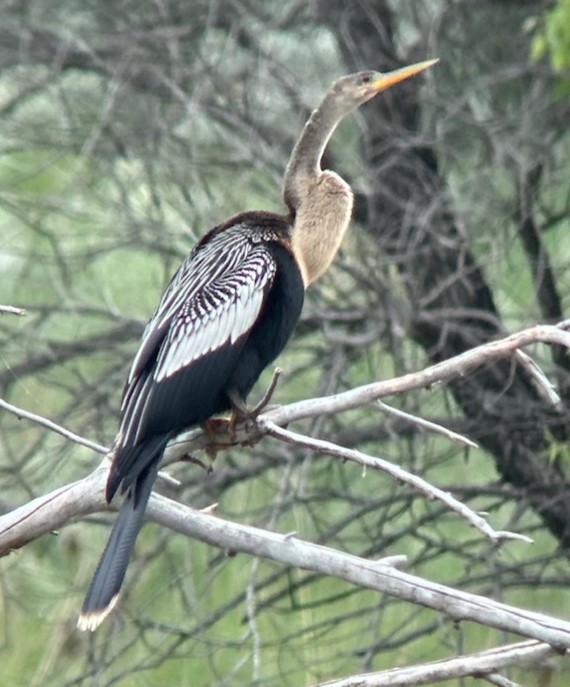Anhinga found at Boulder pond draws 100s of birders
The Anhinga discovered June 2 on a pond near Boulder Creek has quickly become a Colorado celebrity, attracting hundreds of birders and passersby in the weeks since she appeared. Local news media spread the word further, with coverage in the Denver Post and on Channel 9 News on June 12.
“I don’t think, in my 48 years of birdwatching, any bird has created as much interest as this. She’s been seen by at least 500 people, and possibly more by now,” said Peter Gent of Boulder, chair of the Colorado Bird Records Committee. He’s seen the Anhinga six times, rushing out on June 2 when the report first came in, and returning since then with friends. “That first day was pure jubilation,” Gent said.
Greg Levandoski of Longmont made the first sighting while driving along 95th Street just north of Boulder Creek. He spotted a large black bird in flight and recognized it from many previous sightings in Mexico and Central America. He’d also recently listened to a friend’s podcast about an Anhinga that turned up at a wildlife sanctuary in Massachusetts.
“I immediately pulled over, in awe of what I was looking at,” he said. He grabbed a camera and took photos as the bird was flying upward. “Shortly after taking the shots, the Anhinga went into a steep dive; I looked around and saw a large falcon, presumably a Peregrine, and quickly looked back to the Anhinga, only to see it disappear into ponds well east of 95th and out of view of the road.” Levandoski uploaded an eBird checklist, not yet realizing it was only the fourth documented sighting of an Anhinga in Colorado. (The Massachusetts sighting was also the fourth documented in that state.)
Proof of the first two known sightings, in Aurora in 1927 and along Coal Creek in what is now Broomfield County in 1931, came when the birds were collected and delivered to the then-Denver Museum of Natural History. The third Colorado sighting of the tropical long-necked “snake bird” was on May 3, 2003, when Glenda Brown spotted a female Anhinga flying a half-mile away over the fields near Barr Lake. “The jizz was wrong for a Cormorant,” Brown noted in her submission. She alerted Randy Siebert, who was nearby with a scope. With an eye on the bird for about five minutes, he confirmed Brown’s identification.
This time, the errant Anhinga settled in, finding plenty to eat in the ponds, which are on private property.
“Around mid-morning, it gets up and flies around, but always comes back to that same pond,” Gent said. On a recent visit, he observed the Anhinga catch and eat fish three times in its species-specific style. “Anhingas feed on fish exclusively. They catch the fish by spearing it with the bill,” Gent said. “When it comes up, the fish is stabbed on the bill. Then the bird flips its head, throws the fish up in the air and catches it in its mouth. There are four species worldwide in this family. They all do that, and they are the only family of birds that do that.”
The rare visitor has led to a frenzy of birding along 95th. A roadside restoration project under way in the area has been trampled by some birders. “Be mindful of the impact crowds can have when a rare bird is found,” Levandoski noted, to avoid giving birders a bad name.
— Heather McGregor, Colorado Birds science editor

